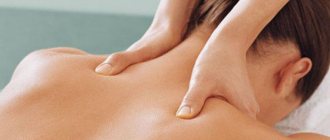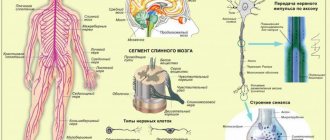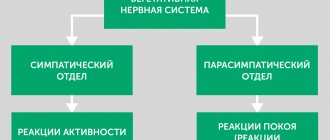Panic and osteochondrosis
Panic attacks and osteochondrosis are interrelated with each other by several syndromes:
- Radicular syndrome. The pathogenesis of osteochondrosis is based on deformation of the articular surfaces and joint cavity. At the same time, it turns out that there is pressure on the surrounding organs and tissues (neurovascular bundles running along the vertebral bodies). Pinched nerve endings cause pain in the limbs and at the site of injury (neck). Innervation in the spinal cord is also disrupted (damage to reflex arcs - motor and sensory).
- Vertebral artery syndrome. When the vertebral arteries, which run along the upper cervical vertebrae, are compressed by deformed bone structures, partial hypoxia of the brain occurs. The disturbances primarily affect the auditory and visual centers (these zones receive 60% of their nutrition from these compressed vessels). This syndrome has varying degrees of severity, since the arteries are paired and compression does not often occur symmetrically on both sides. With one-sided damage, blood flow will be restored compensatory at the expense of the other. And it is also necessary to remember that the brain has many collaterals and, if necessary, blood circulation will be carried out at the expense of other structures.
- Diencephalic. Associated with impaired nutrition of the diencephalon (hypothalamus, pituitary gland). This is the main organ of endocrine and nervous regulation (hypothalamus) and it is here that the center of fear and rage (among others) are located. Insufficient nutrition in this area can trigger all the symptoms of an attack. But the severity of the syndrome will depend on the state of the body, since in full health this syndrome will not be expressed enough to make a diagnosis of a panic attack. But in the presence of atherosclerosis - deposition of adipose tissue in the vessels and a sharp restriction of blood flow - the severity of the syndrome increases sharply.
The severity of each syndrome is individual.
How cervical osteochondrosis “presses” on an artery
By causing stenosis of the vertebral arteries, cervical osteochondrosis can also provoke panic attacks. This disease itself is defined as a degenerative (leading to destruction) and dystrophic (arising from lack of nutrition) pathology. Lack of movement and poor nutrition deplete the spine: vertebrae become fragile, intervertebral discs crumble, and ligaments tear.
The vertebrae, weakened by a lack of calcium and vitamins (the smallest and most fragile in the entire spine), begin to sag and shrink. Dehydrated intervertebral discs (the most mobile), which also lack protein, are flattened, destroyed and squeezed out of the vertebrae. The spinal column itself shrinks in size: it is difficult for it to support a heavy head. To ensure its normal support, the surrounding muscles are in constant tension, which leads to their spasm (inability to unclench).
Muscle spasm compresses the blood vessels and is the first cause of arterial stenosis: the pain radiates in shocks to the back of the head - vertebral artery syndrome develops.
Blood stagnates in spasmed muscles, which leads to inflammation. Flattened intervertebral discs, forming protrusions and hernias, injure the tissue of ligaments and muscles, again causing inflammation and swelling.
Swelling in the cramped cervical region is another factor of pressure on the vertebral arteries.
Thus, cervical osteochondrosis inevitably leads to arterial stenosis, possible oxygen starvation of the brain and can, on this basis, provoke panic attacks.
If we add to this the severe pain that is accompanied by the movement of inflamed muscles, pinched nerve roots with numbness of the limbs, then it can be argued that for the central nervous system, cervical osteochondrosis is a source of constant alarming signals.
Symptoms of pathology
With cervical osteochondrosis, panic attacks have a number of symptoms. The degree of severity will depend on the degree of circulatory impairment and pinching of the nerve roots. Typical symptoms:
- It starts with anxiety and unreasonable anxiety. Gradually the feeling grows, paralyzing normal life activities. Confusion.
- Pulse increases, tachycardia. Tightness and discomfort in the heart area. Sometimes this symptom mimics a stroke.
- Feeling of lack of oxygen. The patient gasps for air. The respiratory tract is in absolute physiological norm (muscle spasm is possible in 5% of cases).
- Increased sweating.
- Violation of active and passive movements (tremor). Gait disturbance or complete loss for some time. Convulsions are possible.
- Intestinal spasm, which can equally lead to diarrhea or constipation.
- Spasm of smooth muscles extends to the bladder (frequent urge without need).
- Headaches, hearing impairment - noise, crackling and vision (floaters before the eyes, loss of visual fields, mosaic).
Restlessness and anxiety are the first symptoms of pathology.
The result is a pre-syncope or fainting state (short-term loss of consciousness).
Fear is a characteristic basic instinct for every person and it has a number of distinctive features from a panic attack:
- justified;
- somatics (physical manifestations) are not involved;
- long-term (sometimes fear can haunt you all your life);
- less pronounced;
- there is a source (arachnophobia, claustrophobia).
Signs such as loss of time and space (derealization), as well as lack of recognition of one’s own personality (depersonalization) are quite rare.
Only with frequent attacks with a possible transition to psychiatry (development of schizophrenia, manic-depressive syndrome).
Panic attacks or walking in circles of hell
Those susceptible to this disease will never forget their first attack and its symptoms.
- Suddenly your arms go numb and your legs give way.
- The heart is pounding wildly, severe pain covers the sternum.
- There is a sharp lack of air, shortness of breath begins.
- It is impossible to stop the trembling in the body; it throws it either cold or hot.
- Profuse sweat appears.
- Nausea, bowel and bladder disorders.
- My head is spinning, the ground is disappearing from under my feet.
- It seems to a person that he has entered another dimension, and everything that happens is unreal.
- Under the influence of animal fear that has gripped the entire being, it is impossible to move, or, conversely, panic forces you to run headlong, fleeing from an unknown danger.
Neither visiting doctors, nor mountains of medications, nor sessions of hypnosis and self-hypnosis can save a person from oppressive fear and new attacks. His condition is only getting worse.
Causes of panic attacks
Panic attacks and osteochondrosis have a number of reasons for their development. Although the pathogenesis is clear (impaired blood circulation and innervation), not in all cases a symptom such as an attack will develop.
Common reasons:
- The formation of osteophytes, deformation of the vertebrae and articular capsule with its replacement by connective tissue leads to compression of the arteries.
- Metabolic disorders (calcium, phosphorus, magnesium, zinc).
- Concomitant diseases (vegetative-vascular dystonia, atherosclerosis of brachycephalic vessels). These diseases work as a background, which, even with slight compression of the vertebral arteries, will lead to a pronounced manifestation of a panic attack.
- Genetic feature of the production of adrenaline and norepinephrine in the adrenal glands. So, the so-called “fight or flight” reaction is caused by these hormones.
- Taking medications (quite rare). More associated with taking narcotic analgesics and their abrupt withdrawal. But there is a slightly different mechanism for the development of a panic attack and osteochondrosis occurs only as a concomitant and worsening component.
- Pregnancy. Increased load on the spine and heart even in a healthy state. Changes in hormonal levels. All this leads to a worsening of the course of osteochondrosis and the development of an attack.
- Stress is a sharp change at the hormonal level, which will lead to even greater spasm of the vertebral arteries.
Panic attacks and neck pain develop due to many reasons.
These are the most typical causes of development, but not the only ones. Others will be associated with the presence of concomitant diseases (oncology in terminal stages).
What can trigger a panic attack
Although cervicothoracic osteochondrosis and panic attacks are interconnected, in most cases a provocateur is needed for the development of symptoms. Most often, this may be stress or a situation that the patient views as dangerous (closed space, darkness, large crowds of people, and so on).
Panic can occur when the patient is in an uncomfortable position for a long time, when a significant load is placed on the neck area.
Provoking factors may include changes in weather and excessive mental or physical stress.
Having experienced one panic attack, the patient is afraid of its repetition, which is also regarded by the body as a potential threat and provokes the emergence of a new panic.
Against the background of all the signs of panic, patients often develop hypochondria, and this greatly aggravates both the clinical picture of the attacks themselves and of osteochondrosis.
Biochemical connection between osteochondrosis and panic
The biochemical connection will be based on the fact that when blood flow is disrupted, hypoxia and energy deficiency occur in the brain. At the same time, the centers of nervous and humoral regulation (hypothalamus and pituitary gland) are activated. These structures produce hormones and active substances that exercise control over the entire body. An example of some changes in nervous regulation:
- Centralization of blood circulation (spasm of small vessels in the periphery and expansion of large ones). This results in tachycardia and increased heart rate.
- Spasm of smooth muscles (intestines) and increased work of striated muscles (muscles of the legs, arms).
In pathology, increased heart rate and tachycardia are observed.
An example of some changes in humoral regulation:
- Changes in blood pH and amino acid composition.
- Release of adrenaline in the adrenal glands.
- Activation of the production of cortisol (fear hormone).
- Changes in calcium and phosphorus metabolism due to glomerular filtration in the kidneys.
The attack is based on a neurophysiological change in certain brain structures. Active substances have a short lifespan and are produced in small quantities. Therefore, panic attacks usually do not last long.
Factors that provoke panic
With osteochondrosis of the cervical spine, panic attacks do not always develop against the background of absolute calm (60%). There are options for the development of an attack after the action of some external factor. Example of possible influences:
- severe and prolonged physical or mental stress (students);
- postpartum condition (postpartum depression);
- mental disorders;
- excessive long-term or one-time consumption of alcohol in large doses;
- features of the profession (prolonged sitting can lead to pinched nerve roots).
Mental disorders and mental stress can cause the development of panic attacks.
More often, the attack is unprovoked and occurs on its own (a feature of manifestation).
Causes and provoking factors
According to doctors, many patients with various pathologies of the spine experience severe pain and circulatory disorders, but a feeling of fear does not always appear. Experts explain this tendency by characteristics of mental status that are individual for each person.
The main causes of panic attacks in cervical osteochondrosis are:
- Pinching of the vertebral artery - this vessel is damaged first of all, since it passes in a special canal of the processes of all cervical vertebrae, the geometry of which changes with osteochondrosis. The slightest deviation of the bone structures pinches the artery, which disrupts blood circulation in the occipital artery of the brain.
- Compression of the internal carotid artery - damage is usually noted at the entrance to the pyramid of the temporal bone. This contributes to disruption of blood flow along the anterior and middle arteries of the brain and the development of osteochondrosis.
- Pinching of the spinal roots - this provokes excruciating pain in the cervical and brachial plexuses formed by these nerves. In severe cases, numbness of the upper limb may occur.
Typically, all three conditions appear together and provoke a severe pain reaction, shortness of breath and some symptoms of cerebrovascular accident, up to a pre-fainting state. Against the background of such changes, a panic attack develops.
The occurrence of an attack is provoked by the following factors:
- frequent stress;
- increased production of adrenaline;
- emotional lability;
- overdose of certain drugs;
- pregnancy;
- vitamin deficiencies;
- physical overload;
- bad habits.
How long do attacks last and what is their frequency?
Panic attacks vary in intensity and severity. Also different frequency and time of appearance. Treatment tactics will depend on these features. Development options:
- Light form. Frequency no more than 1–2 times a month. Duration does not exceed an hour. Not accompanied by pronounced effects in the body. The clinical picture is mild (not all symptoms).
- Average. Frequency 1–2 times a week. The duration can be several hours. The clinical picture is clear.
- Heavy. Frequency 1–2 times a day. It is difficult to determine the duration (the person is constantly under stress). Fear of new attacks provokes an even worse deterioration in the condition. The clinical picture is usually accompanied by convulsions (similar to an epileptic seizure).
Panic attacks can occur in several forms.
In most cases, the attack lasts no more than 20 minutes and passes without a trace.
Definition of disease
Episodic paroxysmal anxiety is the scientific definition of a panic attack. Paroxysm is the highest degree of progression of a painful attack. The feeling of anxiety, reaching the point of irresistible horror, lasts from several minutes to two hours. This state returns again and again, the whole life turns into a continuous expectation of horror.
The name of the disease – “panic attack” – was given by American doctors at the end of the 20th century. It is included in the International Classification of Diseases as a type of neurosis “based on somatoform dysfunction of the autonomic nervous system.”
- Somatic is bodily. That is, in form it is expressed as a bodily illness: a heart attack; dyspnea; nausea, intestinal and urinary disorders, etc. But only in form - in fact, the heart, lungs, and all other organs are healthy.
- Dysfunction – disruption of work, incorrect performance of a task.
- The autonomic nervous system controls the internal functioning of the body: it is responsible for vascular tone, heart contractions, hormone production - for all important and subtle processes in the activity of internal organs. While the central nervous system is responsible for connecting the body with the outside world.
Dysfunction of the autonomic nervous system in Russian medicine is also called vegetative-vascular dystonia. In the case of panic disorders, it manifests itself in the fact that it forces all organs to work in mortal danger mode (explosion, disaster, terrorist attack), when in fact there is no visible danger. Periodically, from one to four times a week, a person feels on the verge of death, while ordinary people experience this condition only a few times in their entire lives.
Diagnostics
Diagnosing a panic attack is difficult, but not due to the lack of clinical manifestations. This symptom accompanies many other diseases (withdrawal syndrome, schizophrenia). And it is not always possible to establish the root cause of the development of this symptom (the correctness of treatment depends on the correct diagnosis).
Approximate scheme (new studies are added if necessary):
- Examination and history taking. Allows you to identify complaints characteristic of osteochondrosis (pain and impaired movement in the limbs and neck, numbness of the limbs) in addition to complaints of attacks.
- X-ray of the spinal column. Allows you to confirm the diagnosis of osteochondrosis as the root cause of panic.
- CT/MRI. As a final method to understand the presence of anatomical disorders in the brain.
- Ultrasound of the carotid arteries - allows you to determine the presence of atherosclerosis (as an aggravating factor).
As a diagnosis, an ultrasound of the carotid arteries may be required.
Laboratory data - HD, CBC, OAM - are acceptable only for differential diagnosis. Changes in calcium metabolism and changes in pH are not etiological specifically for a panic attack (they occur in almost every disease).
Initially, the doctor deals with this problem by a neurologist. If necessary, additional consultations are prescribed (rheumatologist, psychiatrist).
Therapy methods
Treatment is primarily aimed at eliminating the cause (osteochondrosis). Treatment includes:
- drug therapy;
- physiotherapy and exercise therapy.
Drug treatment is selected by the attending physician.
Prescribed only by a doctor.
Medicines
Treatment includes the following drugs:
- NSAIDs as the main choice for osteochondrosis. The action of drugs from this group is associated with anti-inflammatory, analgesic and antipyretic effects. Example: Piroxicam, Tenoxicam, Diclofenac, Indomethacin.
- Analgesics (painkillers). Mandatory group of drugs due to severe pain syndrome. Example “No-shpa”, “Ketanov”, “Ketanol”, “Spazmalgon”, “Analgin”.
- Chondroprotectors – reduce the destruction of cartilage and have a regenerative function. Example: Chondroitin sulfate, Hyaluronan, Piaskledin, Alflutop.
- Corticosteroids. Hormone therapy is used in extreme cases (severe side effects). The most famous is Prednisolone.
- Sedatives and antidepressants. They relieve the attack itself (it is acceptable to use it during the first attacks of anxiety). Example "Afobazol", "Grandaxin".
- Medicines that improve blood circulation and metabolism. Example "Vasobral".
As an addition to the main treatment, it is worth using multivitamin complexes for bones and joints (selection is individual).
Physiotherapy and gymnastics
Physiotherapy should act simultaneously on osteochondrosis and on stabilizing neurohumoral functions in the body:
- Acupuncture is a point mechanical (special needles) effect on body tissues. Effect on the most sensitive areas (projections of nerve bundles).
- Magnetic vacuum therapy is a simultaneous combination of mechanical action (vacuum) and massage techniques.
- Magnesium electrophoresis effectively relieves muscle spasms.
- Magnetic therapy does not have an irritating (unlike phonophoresis) effect on tissue.
- Ultrasound exposure is another harmless procedure that does not give any unpleasant sensations (does not provoke an attack and has a therapeutic effect on the underlying disease).
Physiotherapeutic procedures have a beneficial effect on the body.
It is acceptable to use massage techniques (self-massage, classic, hot stones) as treatment. Positive sides:
- relieves symptoms of the underlying disease;
- provides relaxation (especially in combination with herbal medicine);
- reduces anxiety.
A set of exercise therapy exercises provides a general strengthening function and is more aimed at osteochondrosis than at the treatment of panic attacks. Positive aspects for frequent attacks:
- improves blood circulation;
- enhances concentration and composure.
Therapeutic exercises for cervical osteochondrosis can improve blood circulation.
In addition, any physical activity leads to the production of endorphins and enkephalins in the brain (the hormone of happiness).
How to eliminate an attack
The attack itself, in mild or moderate form, does not require medical intervention. In severe cases, urgent hospitalization is indicated (severe convulsive syndrome and smooth muscle spasm).
Approximate diagram:
- go out to an open, well-ventilated area (yard, street);
- deep breathing (possibly into a bag);
- concentration on any foreign objects (switching consciousness);
- is in a sitting position for some time.
To eliminate an attack, it is enough to go out into the fresh air.
If the attack worsens and heart pain and suffocation appear, hospitalization in a hospital is required.
What to do with VSD and cervical osteochondrosis
VSD syndrome during panic attacks and cervical osteochondrosis have a common etiology (circulatory disorders). Vegetative-vascular dystonia is not a completely legitimate diagnosis (the concept is too vague and imprecise). Requires careful diagnosis and identification of the cause (a relationship is possible not only with osteochondrosis).
General points:
- common causes;
- common pathogenesis (clamping of blood vessels);
- damage to various organs and systems (heart, gastrointestinal tract).
Circulatory disorders in osteochondrosis and VSD
Differences in diseases:
- with dystonia, manifestations of the brain rarely occur (panic attacks are rare, the clinical picture is weak);
- severe impairment of motor activity in osteochondrosis (pain in the limbs and back, numbness, tremor).
The diseases are often difficult to differentiate from each other.











